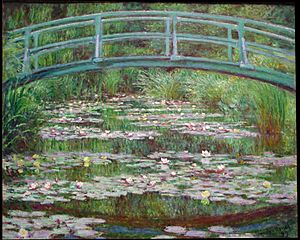Japanese Footbridge facts for kids
Japanese Footbridge is a famous painting by Claude Monet. He used oil paints to create it in 1899. The painting is about 81.3 cm tall and 101.6 cm wide. You can see it today at the National Gallery of Art.
Monet's Garden in Giverny
In 1893, Claude Monet moved to a house in the countryside of Giverny, France. He loved nature and spent a lot of time creating a beautiful garden there. He transformed a wet, swampy area into a lovely pond filled with water lilies. This pond became a huge source of ideas for his art.
Monet even built a special Japanese-style bridge over his water lily pond. This bridge and the garden around it inspired many of his paintings.
What Makes This Painting Special?
In 1899, Monet painted 12 different artworks that focused on his garden and the Japanese Footbridge. When these paintings were shown in an art gallery in 1900, many art experts noticed how they reminded them of Japanese art.
The painting shows a green, enclosed space. The top of the bridge's arch is placed very high in the painting. This makes the garden feel like a secret, peaceful place. It's almost like a dream world where you can think and relax.
One art critic, Gustave Geffroy, described the painting. He talked about the "tiny pond where some mysterious flowers bloom." He also mentioned "a calm pond, still and deep like a mirror." He said that white water lilies floated on the water, surrounded by soft green plants that reflected in the pond. This shows how detailed and beautiful Monet's painting was.
You can find copies of this painting in many sizes at Art Studio Gallery La Fayette.


